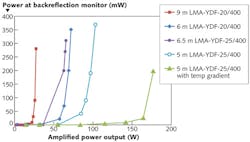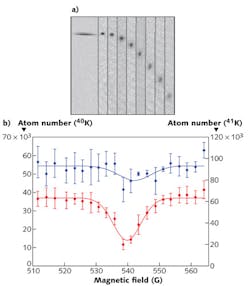FIBER AMPLIFIERS: High-power fiber amplifiers enable leading-edge scientific applications
JIM DING, BRYCE SAMSON, and PEYMAN AHMADI
The adoption of high-power fiber lasers as industrial materials-processing tools has been ongoing for several years and is now expanding into other markets, including the medical and scientific markets. One key factor that has been enabling penetration into the scientific market is the improvements in high-finesse fiber amplifiers, which are now capable of delivering single-frequency linewidths (less than 5 kHz) together with excellent beam quality and stable, linearly polarized output.
Fiber-amplifier systems meeting such specifications have steadily progressed in the last few years from a few watts of output power initially to hundreds of watts of power now. This power scaling has been achieved with developments in fiber technology such as the adoption of stimulated Brillouin scattering (SBS) suppression and mitigation techniques within the fiber, along with improvements to the overall amplifier design. The latest generation of high-finesse, high-power fiber amplifiers delivers power levels exceeding that available from commercial solid-state single-frequency sources and is opening up new scientific applications as a result of the higher power levels and stable, optimized performance.
The problem of SBS in fibers
Stimulated Brillouin scattering in fibers has long been studied with particular reference to telecommunications, where the effect of long fiber lengths (tens of kilometers) can reduce the SBS threshold, limiting the signal power that can be transmitted. In today's rare-earth-doped high-power fiber lasers and amplifiers, the fiber lengths are much shorter—typically a few meters to a few tens of meters. As a result, the SBS threshold is much higher, in the range of a few to hundreds of watts. The effect of SBS on the transmitted signal is seen as a rapid rise in the backreflected Stokes wave, rising exponentially as the output power exceeds the SBS threshold.
One simple means to increase the SBS threshold is to enlarge the fiber core and to scale up the effective mode field, using so-called large-mode-area (LMA) fibers (see Fig. 1). By scaling the core diameter from that of standard telecom fibers (typically around 5 to 10 μm core diameter) to a state-of-the-art LMA fiber with a 20 or even 25 μm core diameter, the SBS threshold can be raised to higher than 50 W for fiber lengths relevant to commercial fiber amplifiers (5 to 10 m). With modern fibers and techniques such as coiling and mode matching to help maintain beam quality, it is possible to get near-diffraction-limited beam quality from such LMA fibers, at least for fibers with core diameters of 25 μm or less.1-3 Furthermore, polarization-maintaining LMA fibers are also available with a range of different design parameters. Thanks to this new generation of fibers, it is now possible to amplify narrow-linewidth polarized sources to the much higher power levels that many leading-edge scientific applications now require.
Atom trapping and cooling
Optical dipole traps created by tightly focused off-resonance laser beams were initially proposed for laser cooling and trapping of neutral atoms.4 Early work with these traps was plagued by short trap lifetimes due to excessive atom heating. Laser-intensity noise and pointing instabilities were quoted as the main heating mechanisms. The advent of very stable high-power fiber lasers has overcome these limitations, and quantum degenerate gases are now routinely created and studied in optical traps. With the new generation of fiber amplifiers, optical dipole traps have become an essential tool, spearheading the frontiers of research in ultracold atomic and molecular physics.
Tests of fundamental symmetries, atomic-frequency standards, single-atom trapping, creation of quantum degenerate gases, and the development of scalable quantum information-processing systems are some of the research areas in which optical traps are widely used. Another technique, the use of optical lattices formed by two counterpropagating optical traps, has also benefited from the recent development of high-power, narrow-linewidth fiber lasers; it allows neutral-atom qubits to be confined with subwavelength precision, coupling neutral atoms into a cavity mode so that quantum phase transitions in quantum gases can be studied.
At the MIT-Harvard Center for Ultracold Atoms (CUA), we routinely use fiber amplifiers to trap quantum degenerate gases to study the interaction effects on the evolution of these clouds. In one example involving gases of potassium (K) atoms, a time-of-flight picture is taken of a Bose-Einstein condensate of 41K that was loaded into an optical dipole trap (see Fig. 2). This trap was formed by a 5 W laser beam produced from a Nufern fiber amplifier and has a beam waist of 150 μm. This cloud had a temperature of about 400 nK and was held in the optical trap for about 2 s before imaging. Such a feat imposes an extreme stability requirement on the trapping laser beams in order that the heating rate is suppressed below a few nanokelvins per second.In our experiments, the interaction between atoms was manipulated using Feshbach resonances (a particular form of many-body-system resonance), which were induced by exposing the trapped atoms to a uniform magnetic field. In an example of a Feshbach resonance between two isotopes of potassium, 41K and 40K, the trapping potential was created by two 100 μm crossed laser beams with a 1064 nm wavelength using a 40 W Nufern fiber amplifier. We are planning to use fiber amplifiers with even higher power in the near future to make deeper traps for capturing more atoms. This will allow experiments with ultracold quantum gases to be carried out at a higher signal-to-noise ratio.
Other applications
These stable, single-frequency, polarization-maintaining high-power sources are also ideal for coupling to optical cavities used in resonant frequency conversion. Recently, by frequency-doubling the output of a high-power 40 W fiber amplifier, 32 W of 532 nm light was generated.5 High-power visible sources are of interest in display and scientific applications, such as pumping high-power Ti:sapphire lasers.
The Observatoire de la Côte d'Azur (Nice, France) has been evaluating high-power fiber amplifiers for the next generation of European gravitational interferometers, Virgo, which at the moment uses a low-power single-frequency Nd:YAG nonplanar ring oscillator amplified to 50 W in two steps by yttrium vanadate (Nd:YVO4) amplifiers.6 However, next-generation systems are targeting powers of greater than 100 W, combined with low frequency noise spectral density (on the order of 10-6 Hz-1/2), stable linear polarization, and relative intensity noise (RIN) of less than 10-8 Hz-1/2. The obvious advantage of higher-power systems in the 100 to 200 W range would be the improved sensitivity of the gravitational-wave detection.
Raising the SBS threshold in fiber amplifiers to the greater-than-100-W level while maintaining good spatial beam quality may be achieved through improved fiber and waveguide design such as SBS-suppressing fibers, or by external SBS-suppressing techniques such as applying a temperature gradient along the fiber length. Experiments raising the SBS threshold to about 150 W by using a simple temperature gradient along the length of a LMA fiber amplifier have been demonstrated (see Fig. 3).7 The temperature gradient has the effect of shifting the Brillouin frequency in different sections of the fiber amplifier, providing an inhomogeneous broadening of the SBS gain along the fiber and raising the SBS threshold.8In the first set of experiments at Nice, such a fiber amplifier was used in conjunction with an Nd:YAG single-frequency seed source. The suitability of a simple servo loop acting on the amplifier pump diodes to suppress the RIN value was demonstrated, reducing the noise in this experiment to 4 × 10-9 Hz-1/2 between 20 Hz and 1 kHz. Other measurements validated the polarization and beam stability, which, combined with the intrinsic attraction of all-fiber systems (simplicity, maintenance, efficiency, beam quality, lower cost), make this an attractive solution for next-generation gravitational-wave interferometry.
REFERENCES
1. K. Tankala et al., "PM double-clad fibers for high power lasers and amplifiers," Advances in Fiber Lasers, Ed. L.N. Durvasula, Proc. SPIE, 4974, 220 (2003).
2. J.P. Koplow et al., "Single-mode operation of a coiled multimode fiber amplifier," Opt. Lett., 25, 442 (2000).
3. M.E. Fermann, "Single-mode excitation of multimode fibers with ultrashort pulses," Opt. Lett., 23, 52, 1998.
4. S. Chu et al., Phys. Rev. Lett., 57, 314 (1986).
5. J.P. Anderegg et al., "RGB laser generation from fiber MOPAs coupled to external enhancement cavities," Proc. SPIE Fiber Lasers VII: Technology, Systems, and Applications, 7580.
6. C. Gréverie et al., "High power fiber amplifier for Advanced Virgo," Proc. CLEO 2010, paper JTuD36.
7. D. Walton et al., "Kilowatt-level narrow-linewidth-capable fibers and lasers," Proc. SPIE, 6453 (2007).
8. V.I. Kovalev and R.G. Harrison, Opt. Lett., 31, 161 (2006).
Jim Ding and Bryce Samson are at Nufern, 7 Airport Park Rd., East Granby, CT; Peyman Ahmadi is at the Center for Ultracold Atoms, MIT, Boston, MA; e-mail: [email protected].


